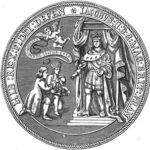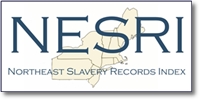The Northeast Slavery Records Index (NESRI) is an online searchable compilation of records that identify individual enslaved persons and enslavers in the states of New York, Maine, New Hampshire, Vermont, Massachusetts, Rhode Island, Connecticut, New Jersey and Pennsylvania. Click below to see our complete collections for each state:
New York – Maine – New Hampshire – Vermont – Massachusetts – Rhode Island – Connecticut – New Jersey – Pennsylvania

Seal of the Dominion of New England (1686)
NESRI indexes census records, slave trade transactions, cemetery records, birth certifications, manumissions, ship inventories, newspaper accounts, private narratives, legal documents and many other sources. The goal is to deepen the understanding of slavery in the northeast United States by bringing together information that until now has been largely disconnected and difficult to access. This allows for searches that combine records from all indexed sources based on parameters such as the name of an owner, a place name, and date ranges.
NESRI also serves communities seeking to understand their histories of enslavement. Our Community-Locality Reports present enslavement records for a state, county, town or city. While our collection of records is never complete and always growing, our customized report provides a head start in the local research process, identifying records that might otherwise take months or years to locate.
The rationale for a project that encompasses New Jersey, New York, and the six states of New England is primarily historical, based on the shifting jurisdictional boundaries of the states involved. For example, a Massachusetts index, for certain times when slavery existed, would include parts of what is now Maine, New Hampshire and Vermont. The Dominion of New England included Massachusetts and extended into Connecticut, Rhode Island, New York and New Jersey. A single NESRI database would enable a locality to access enslavement records from the 17th, 18th and 19th centuries for that location regardless of boundary and jurisdiction changes.
How To Search, Explore and Find Records
Our records can be searched and explored in five basic ways.
- Search for Records of a Community or Locality: The most direct and simple approach is to click on Find Community or Locality Records. You can identify a place like the name of a Town or County or an entire state, and see a customized report of the enslavement records for the selected locality.
- Search for Specific Records: By clicking on General Search you can get a listing or records based on values for a record field.
- Search for Records Based on an Issue or Topic: By clicking on General Search and selecting a “TAG” you can see records of fugitives, investors, births and many other topical criteria. In the instructions below the tags are explained.
- Search by Drilling Down Into a Table: By clicking on Summary Table of Records you can start with a general table with counts of records, and by clicking on any number you can see the records counted.
- See records in topical articles: We post articles based on enslavement records such as Art of Enslavement which presents images of enslaved people and their enslavers in New York. These articles are automatically updated when additional records are indexed.
The rest of this article provides more information about each type of search.
Community or Locality Searches
By clicking on Find Community or Locality Records
You can identify a place like the name of a Town or County or an entire state, and see a customized report of the enslavement records for the selected locality. Our search tool produces a general report about enslavement in a selected geographical area within the NESRI states. If you select only a state you will see all of the records for the state. If you also select a county then only that county’s records will be presented, or you can focus in on a particular locality like the name of a town.
You can also access this from the general menu by clicking on Find Community or Locality Records.
We are gradually updating the search tool, but as of now it produces:
- A general table with counts of various types of records. When you click on a number you see the records that were counted.
- A list of the census records that, in certain years counted the number of enslaved people in the locality.
- A list of the enslavers in the locality.
Search of Specific Records
By clicking on General Search you can get a listing or records based on values for a record field. Generally, the best starting approach is to select a state and then enter one search criterion in the form ( such as “Smith” for the owner last name) and then select the “search” button at the bottom of the form. This will produce all of the records meeting the search criterion. For our example, there are more than 500 records in the State of New York with “Smith” as the last name of the owner.
A next step is to click on “search again” at the top of the form and add another criterion (such as County or Borough equals “Albany”) and this produces the Smiths residing in Albany County.
To start over for a fresh search, select “Search” on the main menu.
To focus on a particular owner, enter the last and first name as criteria. If that produces several persons, adding a County or Borough or a Locality can narrow the search.
It is also possible for search for enslaved persons by name although the results are limited because most of the records refer to slaves only by the first name.
Search for Records Based on an Issue or Topic
By clicking on General Search and selecting a “TAG” you can see records of fugitives, investors, births and many other topical criteria. In the instructions below the tags are explained.
Tags are codes that, when used in a search, identify a special circumstance or issue. You can select a tag using the drop-down menu at the top of the search form.
The following is a list of the tags:
- BON: These are records of slaves who escaped to the British during the Revolutionary War and who subsequently emigrated to Canada as free persons.
- LSTD: The are records of slave transactions in Louisiana where the enslaved person was born in New York. Their enslavement in Louisiana may have been illegal in New York.
- SJTR: These are records on enslaved persons and owners identified in Sojourner Truth’s biography. We have an essay explaining these records.
- RAN: These are records based on runaway slave notices and ads.
- ABN: These are records of babies born to enslaved women who were officially abandoned by the slave owner and placed up for foster care by the local government.
- SALE: This is a record of a slave trade transaction.
- EMN: This is a record of an emancipation of a slave.
- CEM: A cemetery marker or record.
- SEN: Tags starting with SEN followed by a year identify slave owners who were members of the New York State Senate for the year specified. We have an essay explaining that a majority of Senators in the 1790 and 1800 Senate owned slaves.
- JAY: Slavery and the extended family of John Jay.
- SHIP: A record of a vessel transporting enslaved people.
- INVNY: This tag identifies a New Yorker investing in a slave ship delivering enslaved people to New York.
- INVI: This tag identifies a person not from New York (typically from Europe or the Caribbean) investing in a slave ship delivering enslaved people to New York.
- HOUSE: This tag identifies a record associated with a residence that still exists today.
- RAIL: This is a record of a person enslaved in a southern state arriving in New York seeking freedom.
- CMPT: This is a record of the NY State Comptroller’s Office compensating towns and cities for the costs of care for abandoned slave children.
- DESC: The record contains the name of an early descendant of the enslaved person, to assist genealogists.
- ADV: The record contains the name of a person who tried, in a direct and individual way, to advance or preserve the freedom of the enslaved person.
- LEGAL: The record involves a legal case or trial.
Search by Drilling Down Into a Table
By clicking on Summary Table of Records you can start with a general table with counts of records, and by clicking on any number you can see the records counted.
See Records in Topical Articles
We post articles based on enslavement records such as Art of Enslavement which presents images of enslaved people and their enslavers in New York. Another example is the summary of investors and slaveships. These articles are automatically updated when additional records are indexed.
Scope of the Collection
The purpose of this project is to assemble a searchable index of records of slavery in New England identifying individual enslaved persons and enslavers. The project does not seek to take custody of or manage records, but rather to provide a comprehensive index of the records that exist. What are the types of records we are indexing?
- Colonial census records
- United States Census records
- Slave Trade Records: Emancipations
- Fugitive advertisements and announcements for enslaved people
- Gradual Abolition Records: Connecticut, New Jersey and Rhode Island had “gradual abolition of slavery” laws like New York. Massachusetts freed enslaved people at the time of abolition. The graduate abolition laws imposed periods of servitude of children born to enslaved mothers and records of birth and eventual emancipation must be included in the database.
- Treaty of Paris Records: The Book of Negroes is a hand-written list of more than 3,000 formerly enslaved persons allowed to emigrate to Nova Scotia in 1783 because of their service to the British during the Revolutionary War.
- Cemetery Records
- Slave ship Records: NESRI will index records of slave ships that delivered enslaved people to or from the New England states, including records of ownership.
- Portraits and Sculptures and other memorializations: NESRI will index art representations of enslaved persons and enslavers from the northeast states.
- Court records: These include criminal and civil records.
- Records from other indices: These would include records of enslaved persons in Louisiana who were born in a northeast state, such as Simon who was born in Massachusetts in 1750 and sold in Louisiana in 1772.



